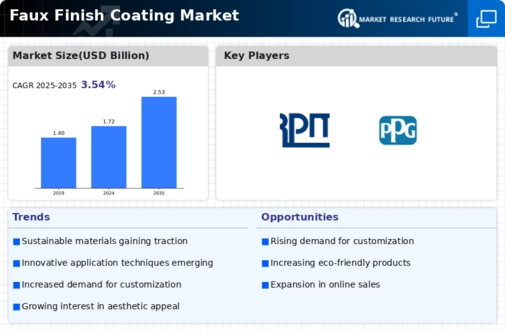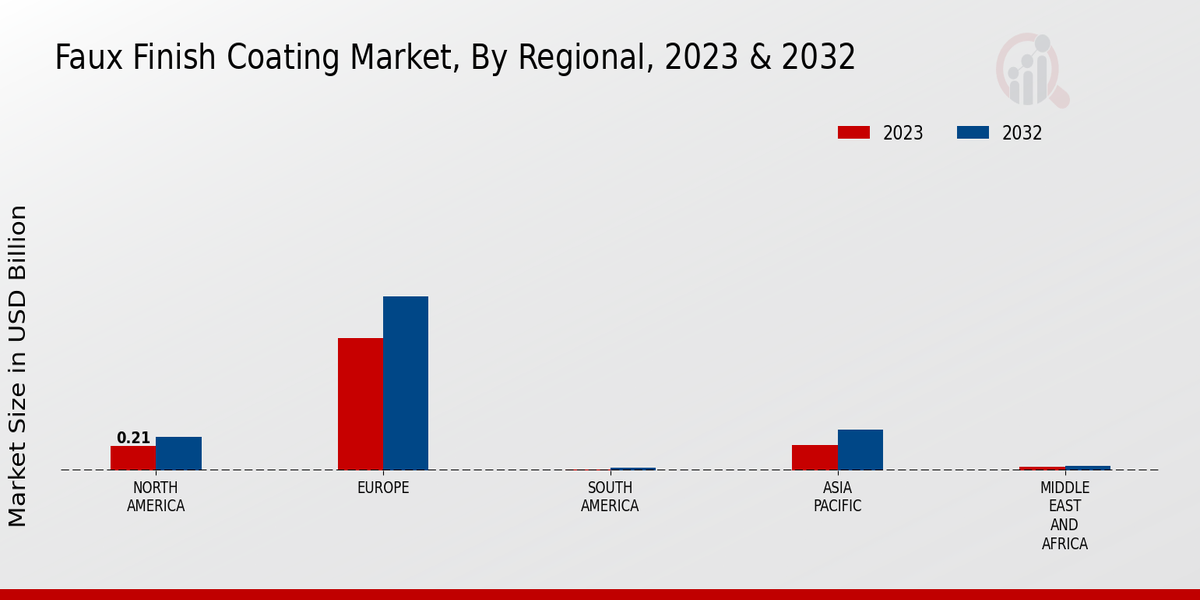Market Growth Projections
The Global Faux Finish Coating Market Industry is poised for substantial growth, with projections indicating a market value of 1.72 USD Billion in 2024 and a potential increase to 2.53 USD Billion by 2035. This growth trajectory suggests a compound annual growth rate (CAGR) of 3.56% from 2025 to 2035. Such figures reflect the increasing adoption of faux finishes across various sectors, including residential, commercial, and industrial applications. As the market evolves, it is likely to witness innovations in product offerings and application techniques, further enhancing its appeal to a broader audience.
Growth in the Construction Sector
The Global Faux Finish Coating Market Industry is significantly influenced by the growth of the construction sector. As urbanization accelerates, there is an increasing need for residential and commercial buildings, which in turn drives demand for decorative coatings. The market is projected to grow at a CAGR of 3.56% from 2025 to 2035, reaching an estimated value of 2.53 USD Billion by 2035. This growth is fueled by the rising number of construction projects globally, as builders and architects seek innovative solutions to enhance the aesthetic appeal of their structures. Faux finishes offer a cost-effective way to achieve high-end looks, thereby supporting market expansion.
Rising Demand for Aesthetic Interiors
The Global Faux Finish Coating Market Industry experiences a notable increase in demand driven by the growing consumer preference for aesthetically pleasing interiors. Homeowners and commercial establishments are increasingly opting for faux finishes to enhance the visual appeal of their spaces. This trend is particularly evident in urban areas where real estate competition is fierce. The market is projected to reach 1.72 USD Billion in 2024, reflecting a robust interest in decorative coatings. As consumers seek unique designs and textures, faux finishes provide an affordable alternative to traditional materials, thereby expanding the market's reach across various demographics.
Sustainability Trends in Construction
Sustainability has become a pivotal factor influencing the Global Faux Finish Coating Market Industry. With an increasing emphasis on eco-friendly materials, manufacturers are innovating to create faux finishes that utilize sustainable resources and low-VOC formulations. This shift aligns with global initiatives aimed at reducing environmental impact, appealing to environmentally conscious consumers. As a result, the market is likely to see a surge in demand for sustainable faux finishes, which not only enhance aesthetics but also contribute to healthier indoor environments. This trend may significantly shape the market landscape in the coming years.
Increased Consumer Awareness and Education
Consumer awareness regarding the benefits of faux finishes is on the rise, positively impacting the Global Faux Finish Coating Market Industry. Educational initiatives and marketing campaigns by manufacturers are helping consumers understand the versatility and advantages of faux finishes, such as durability and ease of maintenance. As more individuals become informed about the options available, the demand for faux finishes is likely to increase. This heightened awareness is particularly prevalent among younger homeowners who prioritize unique design elements in their living spaces. Consequently, the market is expected to benefit from this trend as consumers seek to personalize their environments.
Technological Advancements in Coating Applications
Technological advancements play a crucial role in shaping the Global Faux Finish Coating Market Industry. Innovations in application techniques, such as spray technology and advanced rollers, have improved the efficiency and quality of faux finish applications. These developments allow for more intricate designs and faster project completion, appealing to both professional contractors and DIY enthusiasts. As the market evolves, the integration of smart technologies, such as augmented reality for design visualization, could further enhance consumer engagement and satisfaction. This technological evolution is expected to drive market growth as it meets the demands of a diverse customer base.




